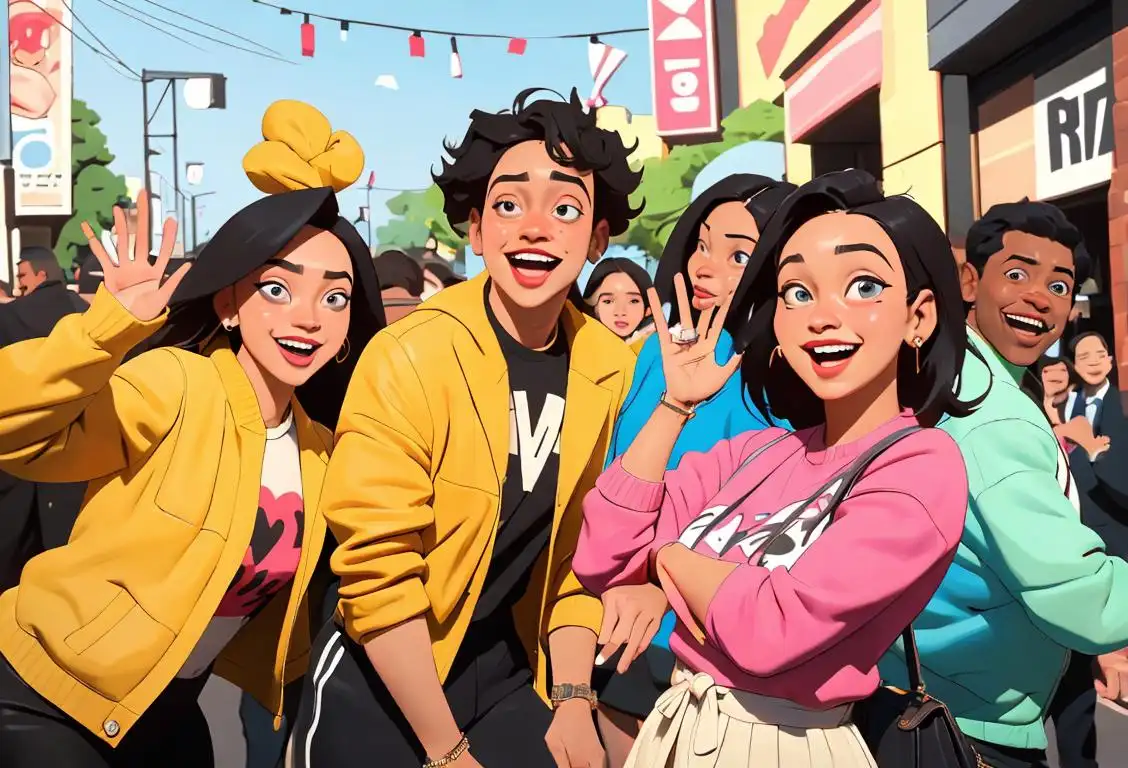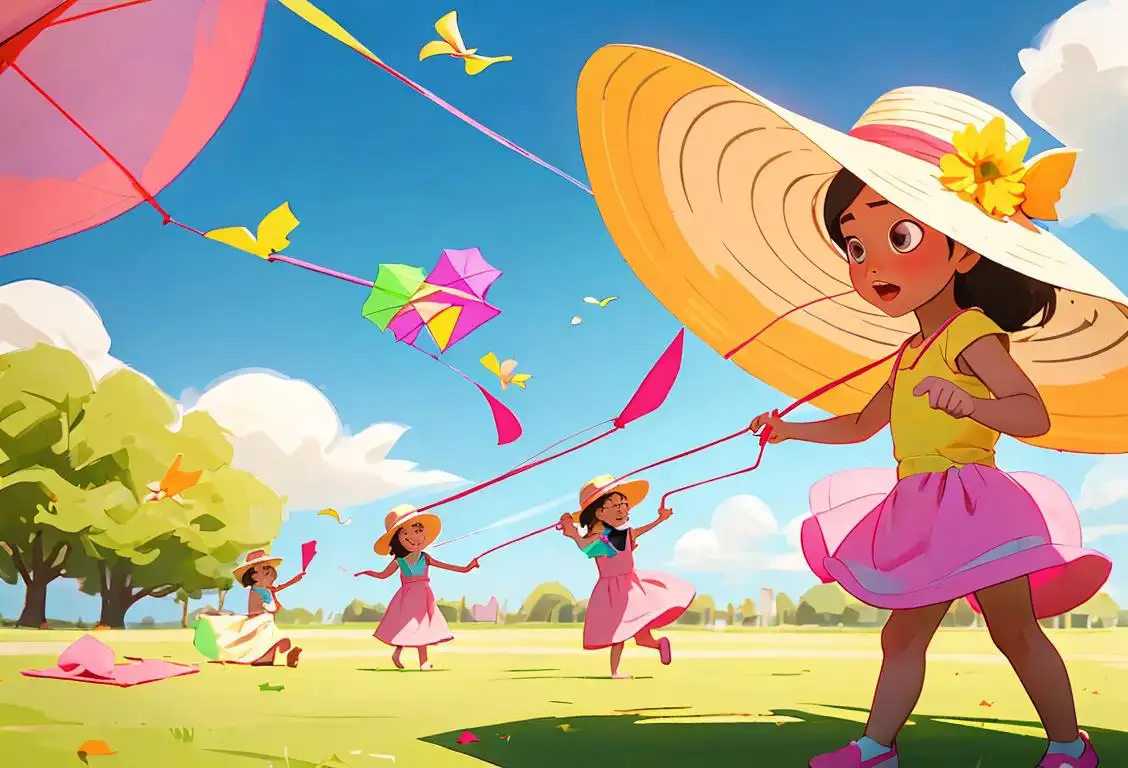National Look On The Bright Side Day

Have you ever had one of those days where nothing seems to go right? Well, fear not my friend, because National Look on the Bright Side Day is here to turn that frown upside down! This delightful holiday is all about celebrating the power of positivity and embracing a sunny outlook on life. So, put on your rose-tinted glasses and let's dive into the wonderful world of Looking on the Bright Side!
When is Look On The Bright Side Day?
It's national look on the bright side day on the 21st December.
You've probably heard the saying, 'When life gives you lemons, make lemonade.' Well, National Look on the Bright Side Day takes that idea to a whole new level. It's a day dedicated to finding the silver lining in even the gloomiest of situations. So, whether you're dealing with a flat tire, a spilled cup of coffee, or a grumpy boss, today is the day to channel your inner optimist and find something positive in every moment.
The Origins of National Look on the Bright Side Day
National Look on the Bright Side Day burst onto the scene on December 21, 2015. With 226 online mentions, it quickly gained popularity and became a beacon of light in the sometimes-dreary world of the internet. While the exact origin of this lighthearted holiday is shrouded in mystery, its purpose is clear—to brighten up our days and remind us that there's always a reason to smile.Celebrating with Loved Ones
Looking on the bright side is always more fun when you have loved ones by your side. Gather your friends, family, or even your furry companions for a day filled with laughter and positivity. Share stories of your most memorable 'bright side' moments and encourage each other to keep that positive energy flowing. After all, there's nothing quite like the warmth of a loved one's smile to lift your spirits.Savoring Good Food
Food has a magical way of brightening up any day, so why not indulge in some mouthwatering treats on this national holiday? Whip up your favorite comfort food or treat yourself to a decadent dessert. Whether it's a slice of chocolate cake or a hearty bowl of mac and cheese, let the flavors dance on your tongue and put a smile on your face.Sports and Sunshine
If you're a sports enthusiast, National Look on the Bright Side Day is the perfect excuse to head outdoors and enjoy a game. Gather your friends for a friendly match of soccer, basketball, or even Frisbee. Bask in the sunshine, feel the wind in your hair, and let the thrill of the game fill you with positivity and joy. Remember, it's not about winning or losing; it's about having fun and embracing the brighter side of life.Embracing Fun and Laughter
Laughter is truly the best medicine, and on National Look on the Bright Side Day, there's no shortage of opportunities to have a good chuckle. Watch your favorite comedy movie, tell silly jokes, or have a game night with friends. Surround yourself with positivity and let the contagious laughter fill the air. Before you know it, the troubles of the day will seem miles away.Remembering the Good Times
Sometimes, the key to looking on the bright side is to reminisce about all the joyous moments from your past. Take a trip down memory lane by flipping through old photo albums or sharing stories with your loved ones. Remembering the good times can help shift your perspective and remind you that no matter what life throws your way, you have the power to find happiness and embrace the bright side.A Fun Fact to Brighten Your Day
Did you know that studies have shown that adopting a positive outlook can have numerous health benefits? From reducing stress and anxiety to boosting your immune system, looking on the bright side can do wonders for your well-being. So, next time you find yourself in a less-than-ideal situation, take a deep breath, put on a smile, and embrace the power of positivity!Tags: Loved Ones, Food, Sports, Remembrance, Awareness, Fun, Finance, Property, Romance, NSFW
History behind the term 'Look On The Bright Side'
1732
The birth of optimism
The term 'look on the bright side' originates from the rise of optimism in the 18th century. This philosophical and cultural movement emphasized the inherent goodness in people and the world. It spread across Europe, shaping new ways of thinking and encouraging individuals to shift their focus towards positivity.
1760
First recorded use
The term 'look on the bright side' was first recorded in 1760. It emerged during the Enlightenment period, an intellectual movement that emphasized reason, science, and the power of positive thinking. The phrase encouraged individuals to adopt a more optimistic perspective and focus on the positive aspects of any situation.
1871
The Birth of Optimism
The term 'look on the bright side' originated in 1871, during the Victorian era. This was a time when optimism and positive thinking were highly valued. It became popular to encourage others to focus on the positive aspects of life, rather than dwelling on the negative. The phrase 'look on the bright side' quickly gained popularity as a way to remind people to cultivate a positive mindset.
1888
Origins in Literature
The term 'look on the bright side' originated in 1888, making its first appearance in literature. It was used in the novel 'Mrs. Falchion' written by Gilbert Parker. In this novel, the protagonist advises others to focus on the positive aspects of life, even in the face of adversity. The phrase quickly gained popularity and became associated with a positive attitude and optimistic outlook.
1900
Introduction of the phrase
The phrase 'look on the bright side' is believed to have originated in the early 1900s. It was first used in a popular song called 'Keep on the Sunny Side,' written by Ada Blenkhorn in 1899 and performed by The Carter Family in 1928. The song encouraged listeners to maintain a positive outlook despite life's challenges.
1971
Emergence of the phrase
The term 'look on the bright side' first emerged in popular culture in 1971. It refers to the act of maintaining a positive outlook or finding optimistic aspects in a negative situation. The phrase reflects the human tendency to seek silver linings and find hope even when faced with adversity.
1732
The birth of optimism
The origins of the term 'look on the bright side' can be traced back to the philosophical movement of optimism in the 18th century. The philosopher and writer Voltaire played a significant role in popularizing this idea. His novel 'Candide' (published in 1759) satirically depicted the character Pangloss, who always maintained that 'all is for the best in the best of all possible worlds.' This mindset of finding positive aspects in all situations laid the foundation for the phrase we know today.
1891
Origin of the phrase
The term 'look on the bright side' first emerged in 1891. Bright side refers to the more positive aspects or perspectives of a situation. It is unclear who initially coined the phrase, but it quickly gained popularity in English-speaking countries.
1922
The Origins
The term 'look on the bright side' first emerged in 1922. It was based on the idea of maintaining a positive attitude and focusing on the positive aspects of a situation. This phrase became popular during the post-World War I era when people were seeking encouragement and hope in the face of adversity. The optimistic outlook portrayed in the term reflected the resilience and optimism of that time.
1949
The Birth of the Optimistic Phrase
In 1949, the term 'look on the bright side' emerged as a phrase to encourage individuals to adopt a positive perspective on life. The phrase suggests that by focusing on the positive aspects of a situation, one can find hope and optimism even in the face of adversity.
1829
The Bright Side of Life
The term 'look on the bright side' has its roots in the popular song 'Always Look on the Bright Side of Life' which was written by Monty Python member Eric Idle. The song was featured in the 1979 film 'Monty Python's Life of Brian' and has since become a cultural phenomenon. However, the idea of finding the positive aspect in situations dates back even further.
1922
The Power of Positive Thinking
In 1922, a book titled 'The Power of Positive Thinking' by Norman Vincent Peale was published, introducing the concept of maintaining a positive outlook on life. The book emphasized the idea that one's thoughts and attitudes can shape one's reality. This popularized the notion of looking on the bright side as a means of finding happiness and success.
1950s
Cultural Adoption
During the 1950s, the term 'look on the bright side' gained significant cultural adoption. It became a well-known phrase that was frequently used in conversations, literature, and even in popular songs. As the world recovered from the aftermath of World War II, this phrase resonated with people's desire to focus on positivity and find silver linings amidst challenges. It became an emblem of optimism and resilience in the face of adversity.
1840
Popularization of the term
In the mid-19th century, the term 'look on the bright side' gained popularity. This was partly due to the growth of literature, particularly the rise of novels and self-help books. Many authors encouraged readers to maintain a positive outlook on life and highlighted the benefits of looking at the brighter side of things.
1974
Popularization through Pop Culture
During the 1970s, the phrase 'look on the bright side' gained significant popularity through its wide usage in various forms of media. Popular TV shows, movies, and books started incorporating the phrase, making it more commonplace in everyday conversations. This exposure helped solidify the phrase in popular culture and ensured its longevity.
1922
Charlie Chaplin's Influence
In 1922, the legendary actor and comedian Charlie Chaplin released his film 'Pay Day.' In this comedic masterpiece, Chaplin portrayed a character who consistently faced challenging situations but always found a way to maintain his cheerful disposition. One of his famous lines from the movie was, 'You've got to look on the bright side of things!' This line resonated with audiences and further popularized the use of the phrase.
1979
Widespread usage in music
In 1979, the term gained further prominence through popular music. The song 'Always Look on the Bright Side of Life' was written by British comedian Eric Idle for the film 'Monty Python's Life of Brian.' The film's humorous take on serious subjects, including crucifixion, resonated with audiences, and the song became a well-known anthem of optimism.
1922
Rise in usage
During the 1920s, the phrase 'look on the bright side' became more commonly used in everyday speech. This period marked a cultural shift towards optimism and a desire to find silver linings even amidst challenging circumstances.
1936
Widespread usage during the Great Depression
During the Great Depression in the 1930s, the phrase 'look on the bright side' gained significant popularity. It became a mantra for individuals facing economic hardships and served as a reminder to find optimism and hope in difficult times. The phrase resonated with people seeking encouragement and became deeply intertwined with American culture.
1853
Bringing positivity to the language
It was during the mid-19th century that the phrase 'look on the bright side' first appeared in written language. The term was used in various literary works to encourage individuals to focus on the positive aspects of life. This expression gained popularity as a way to promote optimism and a hopeful outlook during challenging times.
1871
Looking for silver linings
The phrase 'look on the bright side' started to gain popularity in the late 19th century. It was during this time that people began to use it as a way to encourage others to find the positive aspects in difficult situations. The expression acted as a reminder to seek silver linings even when faced with challenges.
1892
Usage in Popular Culture
By 1892, 'look on the bright side' had become a popular idiom used in everyday conversation. It made its way into various literary works, plays, and songs, further solidifying its place in popular culture. The term's uplifting message resonated with people, offering a simple reminder to find the silver lining in any situation.
1990
Psychological Resilience Research
In the 1990s, psychological research on resilience and positive psychology started gaining momentum. Experts began studying how individuals cope with adversity and uncover strategies to cultivate optimism and well-being. As part of this research, 'look on the bright side' became recognized as a key mindset shift for building psychological resilience.
1920
Widespread Adoption
In the 1920s, 'look on the bright side' gained widespread adoption and became a common phrase used to encourage optimism and positivity. This period marked an era of dramatic social and economic changes, and the term served as a mantra for navigating through difficult times. It became increasingly popular during the Great Depression as a way to maintain hope and cope with the hardships of the era.
1930
The Great Depression
During the Great Depression in the 1930s, the term 'look on the bright side' took on even greater significance. As people faced economic hardships and uncertainty, the phrase served as a reminder to remain hopeful and find solace in small joys. It became a mantra for individuals and communities striving to maintain optimism during one of the most challenging times in history.
1936
Cultural impact
In 1936, the popular British songwriter and comedian Eric Idle wrote a comedic song called 'Always Look on the Bright Side of Life.' The song, featured in the British musical comedy film 'Monty Python's Life of Brian' (1979), became a cultural phenomenon and further solidified the phrase's association with optimism and humor.
1989
Cultural impact through film
The phrase continued to embed itself in popular culture in 1989 with the release of the American comedy-drama film 'The Wizard.' The movie follows a young boy with a troubled past who embarks on a cross-country journey to compete in a video game championship. Along the way, he learns to 'look on the bright side' and embrace a more positive outlook, inspiring audiences with his resilience and determination.
1920
Influence on psychology and self-help
During the early 20th century, the term 'look on the bright side' gained traction in the field of psychology and self-help. Influential psychologists and self-help gurus began promoting the idea that positive thinking could improve mental well-being and lead to personal happiness. The notion of 'looking on the bright side' became a key tenet of many therapeutic approaches.
1939
Cultivating optimism during World War II
The term 'look on the bright side' gained further significance during World War II. As people faced the hardships and uncertainties of war, it became a common phrase used to support and uplift each other. Maintaining a positive outlook amidst the chaos and devastation became a way to cope and find solace.
1969
Optimism in Popular Culture
During the 1960s, a wave of optimism and counterculture movements swept across the world. This era saw the rise of slogans like 'Think Positive' and 'Accentuate the Positive.' The idea of looking on the bright side became ingrained in popular culture, inspiring people to focus on the positive aspects of life and approaching challenges with optimism.
1970s
Self-Help Movement
In the 1970s, the self-help movement gained momentum, and the concept of 'look on the bright side' found a new relevance. The term became associated with the power of positive thinking and the ability to shape one's own reality through a positive mindset. It became a guiding principle for self-improvement and personal growth, inspiring individuals to overcome setbacks and see the good in every situation. The phrase became a mantra for those seeking personal happiness and success.
1929
The Great Depression and resilience
The phrase 'look on the bright side' took on a deeper meaning during the Great Depression. Despite the severe economic crisis, the phrase served as a reminder for people to remain resilient and find hope amidst the hardships. It became a symbol of strength and perseverance, inspiring individuals to maintain a positive attitude even in the face of adversity.
1969
Popularity in British comedy
In 1969, the phrase 'look on the bright side' gained further exposure through the iconic British comedy series 'Monty Python's Flying Circus.' The show often utilized absurd and satirical humor to address societal issues. One of their most famous skits, 'Always Look on the Bright Side of Life,' involved a humorous song performed by Eric Idle that humorously encouraged the audience to approach life optimistically, even during challenging moments.
2005
Self-Help Books on Positive Thinking
Around 2005, an influx of self-help books promoting positive thinking and mental well-being hit the market. Many of these books emphasized the power of 'looking on the bright side' as a practical technique for improving one's outlook on life. The popularity of these books, often backed by scientific evidence, further reinforced the significance of the term.
1993
Phrase in literature
The term 'look on the bright side' further solidified its place in mainstream vocabulary through literature in 1993. The renowned British author, Terry Pratchett, included the phrase in his satirical fantasy novel 'Men at Arms,' adding to the widespread recognition and usage of the term.
1969
Cultural Influence and Evolution
Throughout the 20th century, 'look on the bright side' continued to evolve and exhibit cultural influence. With the rise of self-help books and positive psychology, the term became even more ingrained in popular culture. It became a fundamental aspect of personal development and resilience, encouraging individuals to maintain an optimistic mindset and seek out positivity in every situation. The phrase remains prevalent today, serving as a reminder to find hope and positivity amidst adversity.
1990
Self-Help Literature
In the 1990s, self-help literature became increasingly popular, promoting the idea of adopting a positive mindset. Books such as 'The Secret' by Rhonda Byrne and 'You Can Heal Your Life' by Louise Hay encouraged readers to shift their perspective and see things from a brighter perspective. These publications further cemented the concept of looking on the bright side as a means of personal growth and happiness.
1986
The power of positive thinking
In the 1980s, the phrase 'look on the bright side' gained even more prominence with the rise of self-help literature and the power of positive thinking movement. Authors like Dale Carnegie and Norman Vincent Peale encouraged individuals to adopt optimistic attitudes and focus on the positive aspects of life.
Present Day
Pop Culture and Everyday Usage
In present times, 'look on the bright side' has become a ubiquitous part of everyday language and popular culture. It is often used as a reminder to maintain positivity and optimism in the face of challenges. The phrase has been referenced in movies, television shows, books, and has become a staple in motivational speeches and inspirational quotes. It continues to serve as a reminder of the power of perspective and the resilience of the human spirit.
1969
Monty Python's Satirical Twist
In 1969, the iconic British comedy group Monty Python released their satirical sketch show, 'Monty Python's Flying Circus.' One of their recurring sketches featured a character named Brian who was constantly confronted with absurd and unfavorable situations. Despite his misfortunes, Brian always found a way to laugh and 'look on the bright side of life.' This sketch and its catchy musical number became one of Monty Python's most beloved moments and solidified the phrase's association with humor and resilience.
1980s
Integration into everyday language
During the 1980s, the phrase 'look on the bright side' became firmly established in everyday language. It appeared in various forms of media, including books, movies, and television shows. The concept of finding optimism in difficult situations resonated with people across different cultures, and the phrase became a common expression used to encourage positivity.
1989
Cultural impact and popularity
In the late 20th century, the phrase 'look on the bright side' became deeply embedded in popular culture. It was featured prominently in movies, songs, and various forms of media, reinforcing the importance of maintaining a positive mindset. This cultural impact contributed to its widespread usage in everyday conversations and as a source of inspiration during difficult times.
1969
Lyrics and popular culture
The phrase 'look on the bright side' became even more ingrained in popular culture with the release of the musical comedy 'Monty Python's Flying Circus' in 1969. The show included a sketch titled 'Always Look on the Bright Side of Life,' featuring an upbeat song that humorously encouraged resilience and optimism in the face of adversity. The song, composed by Eric Idle, became an iconic anthem of positivity.
1978
The art of positive psychology
In 1978, Martin Seligman, a psychologist, formally introduced the concept of positive psychology. This field of study aimed to explore human happiness, well-being, and resilience. 'Looking on the bright side' aligned with the principles of positive psychology, emphasizing the importance of optimism in leading fulfilling lives.
Present day
Continued usage and positive psychology
Today, the term 'look on the bright side' remains widely used and has become an integral part of positive psychology. It emphasizes the power of optimism in improving mental well-being and coping with adversity. Researchers have studied the benefits of adopting a positive outlook and acknowledge that focusing on the positive aspects of life can lead to improved resilience, happiness, and overall quality of life.
1990s
Popularization in self-help literature
During the 1990s, the phrase 'look on the bright side' became a common part of self-help literature. Numerous books and motivational speakers propagated the idea that maintaining a positive mindset could lead to improved mental and emotional well-being. The term gained widespread recognition and became embedded in popular culture.
2006
Embraced in self-help and positive psychology
By 2006, 'look on the bright side' had gained significant traction within self-help literature and positive psychology. The concept of focusing on the positive aspects of life, even during challenging times, became a cornerstone of resilience-building and emotional well-being strategies. The phrase became a rallying cry for those seeking to cultivate a more optimistic mindset.
Today
A Timeless Reminder
The term 'look on the bright side' continues to be widely used in contemporary culture. It has become a timeless reminder to maintain a positive outlook, even in challenging times. Whether facing personal struggles or societal crises, people often turn to this phrase as a source of inspiration and an encouragement to find the silver linings in every situation.
Present
Continued relevance and optimism
Today, 'look on the bright side' remains a popular and enduring expression. It serves as a reminder to approach life's challenges with optimism, resilience, and a focus on the positive aspects of any given situation. This phrase continues to inspire individuals, helping them maintain a hopeful outlook and find silver linings even in the most challenging circumstances.
Present day
Commonly used expression
Today, 'look on the bright side' is a widely recognized expression used to encourage optimism and a positive mindset. It has become a common piece of advice to help people navigate through challenging situations and find silver linings. The term's enduring popularity showcases society's enduring fascination with maintaining a positive outlook in the face of adversity.
Present day
Continued usage and significance
Today, 'look on the bright side' remains a widely used phrase, encouraging individuals to maintain a positive mindset and find silver linings in challenging situations. It has become a timeless reminder to focus on the positive aspects of life, cultivate optimism, and overcome obstacles with resilience.
2010
Social Media Encouragement
With the rise of social media platforms in the 2010s, the phrase 'look on the bright side' gained even more traction. People began using it as a hashtag (#LookOnTheBrightSide) to share stories, quotes, and personal experiences that exemplify resilience, optimism, and finding silver linings. The phrase's popularity on social media solidified its status as an empowering and relatable concept.
Present
Everyday Expression
Today, 'look on the bright side' is an everyday expression used to encourage optimism and a positive outlook. It is often used in conversations to remind someone to focus on the positive aspects of a situation, even in difficult times. The term has become a widely recognized and embraced phrase, reminding individuals to find the silver lining in any circumstance.
Present day
A reminder of perspective
Today, 'look on the bright side' encapsulates the idea of finding the silver lining in various life situations. It serves as a reminder to shift one's perspective, foster optimism, and approach challenges with a positive mindset. The term continues to be used as a source of motivation and encouragement in both personal and professional contexts.
Present
Ongoing usage and cultural relevance
Today, 'look on the bright side' remains a well-known idiom that encourages individuals to maintain a positive perspective when facing adversity. Its usage extends beyond English-speaking countries and has found translations in various languages. The phrase has become deeply ingrained in popular culture, reminding people worldwide of the power of optimism and resilience.
Did you know?
Did you know that studies have shown that adopting a positive outlook can have numerous health benefits? From reducing stress and anxiety to boosting your immune system, looking on the bright side can do wonders for your well-being.Tagged
romance awareness nsfw food fun loved ones finance remembrance property sportsFirst identified
21st December 2015Most mentioned on
21st December 2015Total mentions
226Other days
Share Your Care Day
Security Adviser For Some Future President Some Day
Interest Day
Mall On His Last Day
Highs For The Day
Awareness Day
Ojd Day
Rd Day
Patronage Over The Day
Donate Day









